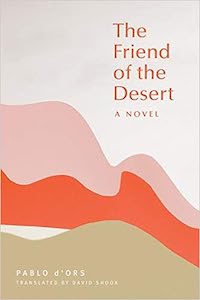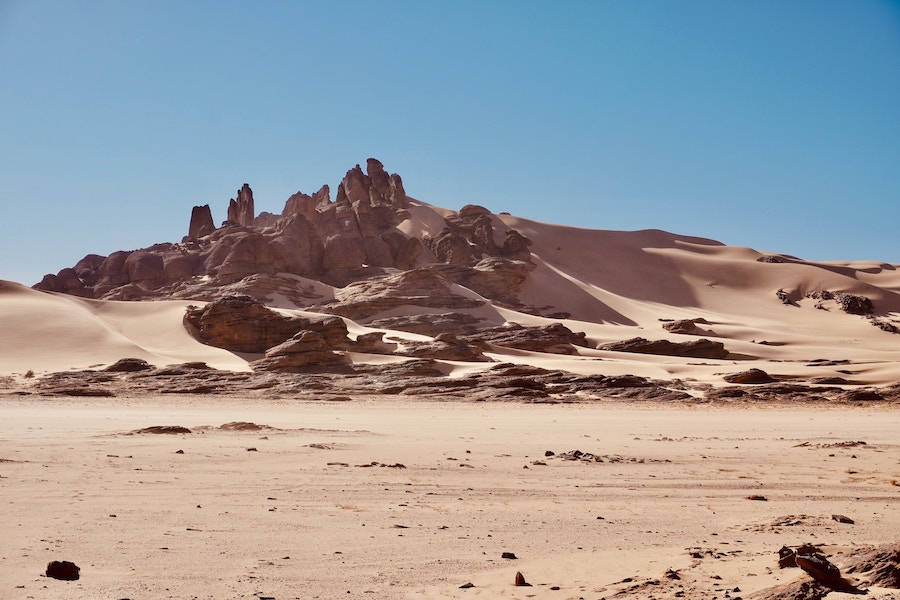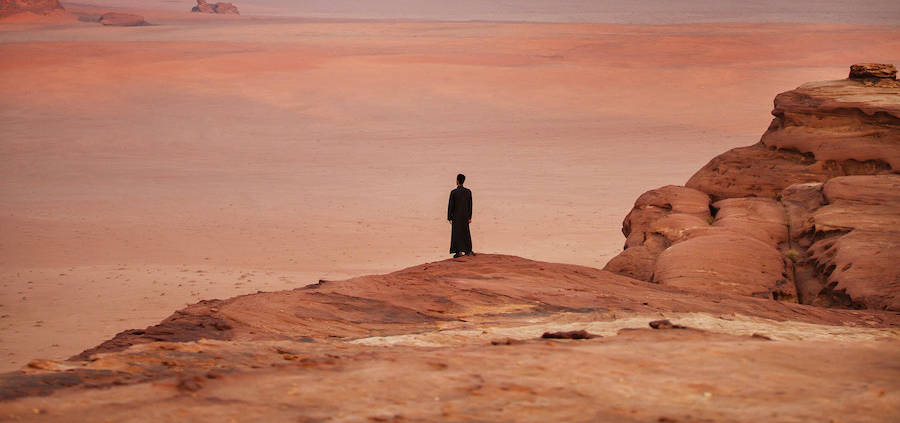Threshold Questions by Richard Lehan

The Friend of the Desert
By Pablo D’Ors
Parallax Press, 2019
$13.95 127 pp
The Friend of the Desert, a short novel by the Spanish writer-priest Pablo D’Ors, tells the story of Pavel, a 42-year-old unmarried man from the Czech Republic who is invited to join an organization of people who travel to deserts called the Friends of the Desert. Over the course of two expeditions to the Sahara with his fellow travelers, Pavel narrates an account of his evolving encounter with the physical, cultural, and interior landscapes generated by the environment. On a third trip to the Sahara on his own, Pavel learns to become a true “friend of the desert” and decides to stay in his new “homeland.”
I read The Friend of the Desert when it was first published in English in 2019 and enjoyed it as a quirky travelogue or “fictional memoir” of personal change. After recently rereading it, however, the novel’s underlying spiritual themes resonated deeper for me. Perhaps informed by my own contemplative practice, the novel offered me a realistic, often poetic “map” of Pavel’s journey from a restless, dissatisfied everyman to a “rooted” contemplative attempting to live an authentic life.
One of the pleasures of reading this novel is being introduced to an accomplished writer who is relatively unknown to an English-speaking audience. Well regarded in his native Spain and in Europe, D’Ors has been writing critically acclaimed short stories and novels since 2000. To date, The Friend of the Desert is the only one of his works of fiction to be translated into English. In 2014, he founded the Amigos del Desierto (Friends of the Desert) foundation with the aim of promoting the practice of meditation. In the same year, Pope Francis made him a consultant of the Pontifical Council of Culture. D’Ors’s book on his personal meditation practice was a best seller in Spain and later published in English in 2018 as Biography of Silence.
At 127 pages, The Friend of the Desert could be described more accurately as a novella, but one that is chock-full of images, written and otherwise. Incorporated into the structure of the book are some unconventional features that highlight the artifice of the exercise and the hybrid character of the narrative. The story is prefaced by an introduction that mimics the structure of a play: “Dramatis Personae,” which introduces the characters in the novel; and “Locations,” which orients the reader to the various (and often exotic) places where the action of the novel occurs. The narrative in the latter part of the novel is imbedded with Pavel’s drawings of the desert and examples of how even his handwriting has been influenced by the desert milieu. On one level, these authorial devices contradict each other. The theatrical features announce to the reader that what follows is a staged performance; the drawings and the stylized way the writing looks on the page add verisimilitude to the novel’s conceit that what you hold in your hands is Pavel’s holistic account of his desert experience. Regardless, together they bring novelty and charm to the reader’s experience of the book.
Like Pavel, most of the other members of the Friends of the Desert are Czech, and the story of their engagement with the Sahara and its associated Arab-Muslim world is told from a European perspective. America’s ubiquitous cultural influence is nowhere to be found. In Pavel’s case, his perceptions evolve over time from disdain, to appreciation, to finally identification with the “other” in terms of both the landscape (the desert) and the community (the oasis town of Beni Abbes). The prose itself is also a departure from the dominant American brand of pared-down minimalism. A courtly, more introspective style comes through in the English translation. Fittingly, the writing becomes more vivid and poetic as the desert reshapes Pavel’s self-understanding and ability to see.
When Pavel first learns of the existence of the Friends from the back cover of a book, he becomes conscious of a vague discontent with his conventional life. He responds by requesting information from the organization about their activities and qualifications for becoming a member. He is invited to meet with Otla Plicka, the organization’s president, and his wife, pana Plickova, at their home in Brno. To his surprise, he is invited to stay overnight, but the couple is inexplicably resistant to providing any information about the Friends. The next morning, Otla curtly drops Pavel off at the train station for his return trip home. That initial rejection presents him with a choice: either move on or put his nascent interest to a further test. Pavel chooses the latter.
Pana Plickova’s reply to Pavel’s second inquiry requests that he refrain from writing unless his “longing for the desert is irresistible.” Pavel is now determined to find out his response to that challenge. He reads all he can about the desert at his city’s library, though he admits that he spends most of his time looking at the photos of deserts in these books. His investigation leads him to information on the Tuareg people, a semi-nomadic tribe that lives across the Sahara. The librarian then directs Pavel to several books on the desert “from a philosophical—or even spiritual—perspective.” That discovery, in turn, expands Pavel’s understanding of the word “desert.” For the first time, it conjures up both a physical and interior place for him.
Two months later, Pavel emails the president of the organization again to tell him that his interest in the desert has only grown. While waiting for a reply, he hangs several desert photos on his bedroom walls. This time it is Professor Pecha, the founder of the Friends, who responds. The professor explains to Pavel that in the past the Friends have indulged people whose professed interest in the desert turned out to be “ephemeral and even fickle.” But since this is Pavel’s third inquiry of interest, the professor says, “the moment for the organization to take you seriously has arrived.” Finally, the professor invites him to join the meetings of the Friends. Pavel’s experience has a parallel to the contemplative journey: answering the threshold question of whether one’s interest in contemplation is merely the curiosity of a dilettante or a longing that will not be deterred.
Pavel’s introduction to the Friends is an adjustment. At his first meeting, none of the members make an effort to educate him on the purpose of the organization. At his second meeting, one member mysteriously warns him three times to leave the organization while there’s still time; another slips her icy hand beneath his shirt when her husband is not looking. More importantly, he learns at that meeting of a man named Charles de Foucauld, venerated by the Friends as a distinguished teacher of the desert. As Professor Pecha speaks, a photo of Foucauld’s face is projected on a large screen in the background. His “most intimate secret,” the professor asserts, “was encoded in the countless hours that he spent in silence and solitude.” The world seeks glory, declares the professor, but Foucauld chose anonymity and obscurity. That last comment awakes in Pavel a desire to know this man more deeply.
Though not included on the list of dramatis personae, Foucauld is an influential character in the novel. A worldly French soldier and explorer turned Catholic priest, Foucauld eventually found his way to Beni Abbes, an oasis in the Algerian Sahara where he lived for several years. From there, Foucauld traveled further south in the desert to live among the Tuareg as a hermit for the rest of his life. In 1916, Sennusi Bedouin tribesmen in revolt against the British murdered Foucauld at his desert home. Pope Francis canonized him as a saint in May 2022. That Foucauld is also a personal exemplar for the author is no surprise; the website of D’Ors’s Amigos del Desierto foundation devotes a whole section to him.
Pavel’s first trip to the Sahara is a disaster. He finds Morocco to be a “dirty, hostile country” and its people “quite inhospitable.” He is particularly displeased with Jehuda, the expedition’s guide, who is conscious of Pavel’s contempt of him and his country and responds accordingly. Two of the Friends’ five planned excursions to the desert are ruined, then their transport van breaks down in the middle of nowhere, spawning a seething discontent among the travelers. Significantly, Pavel reports at that moment that “before the venom poisoned me,” he remembered the face of Charles de Foucauld and his image “sucked the poison of rage from my heart.” Overall, though, Pavel is resentful and resistant to an experience that refuses to conform to his expectations. But the worst part of the trip, he confesses, is the desert itself. It is an “immense disappointment,” looking nothing like the photos in his room back home. His fantasy about the ease with which the desert reveals its secrets to the casual observer evaporates in the suffocating heat. Left counting the days and hours until his escape from the Sahara, he is convinced that his relationship with the Friends and the desert has come to an end.
Upon returning home, he resolves to take down the desert photos in his bedroom but can’t do it. In the weeks that follow, he alleviates his “crushing nostalgia” for the desert by gazing at the photos for long stretches of time. He realizes how unhappy he is at home, “surrounded by mediocrity.” He has an insight: his love for the desert is because it is a place of “absolute possibility . . . a metaphor for the infinite.” The idea of all these solitary people, distinct and distant, united by the same act—contemplating the desert—comforts him. At the same time, he is beginning to understand that the act of contemplation requires time, attention, and perseverance. The paradox is that the gifts sought have already been bestowed freely.
On his second trip to the Sahara, Pavel finds that everything is the same, yet different. The hotels aren’t any cleaner nor are the roads any better. The main difference is Shasu, the 13-year-old guide for this expedition, who captivates Pavel and wins over the rest of the group. When they visit the deserts of Batna and Setif, Shasu warns them of the dangers of the shifting dunes. Pavel also finds himself at the point of “shifting,” no longer the man he was the year before. Wanting a taste of the solitude experienced by Foucauld, he deliberately separates himself from the group and is caught in a sandstorm. Panicked, he calls upon Foucauld “as if I believed in his sainthood.” As the whirling sand beats his body, he experiences “the minute of his salvation”: Shasu, who has gone looking for him, bumps into his body and leads him to safety.

Tin Akachaker, Tamanrasset, Algeria. Azzedine Rouichi / Unsplash
Shasu invites Pavel to meet his family, where he is treated like an honored guest. At dinner, Shasu’s father unexpectedly asks Pavel, “Are you a religious man?” No, Pavel answers, thinking perhaps that it is possible to have a religious attitude toward life without believing in God. Shasu’s father responds: “The desert is the place in the world that God created for himself, for his rest . . . That’s why those who go to the desert enter his territory.” Later in the expedition, the group contemplates the Tindouf desert with their field glasses in “almost religious silence.” When the time comes to move on, someone asks Pavel, “Are you coming?” He answers in his mind: “No, I am not going back.” He imagines that the desert has a voice, repeating in his heart as if it were a prayer: “Don’t go back, don’t go back.”
Pavel sets out alone on his third trip to the Sahara, returning to the places he had visited on the two earlier trips. He stays with Shasu and his family again, but is aware of how he and they have changed in the interim. The trip only begins once Pavel stops traveling from place to place and settles in Beni Abbes, the oasis town where Foucauld once lived. Though D’Ors makes no mention of that fact in the novel, the unstated connection adds weight to Pavel’s sense that he has reached his “homeland,” but as a “sojourner.” Soon after arriving in Beni Abbes, the locals ask Pavel his name. “Shasu,” he replies without thinking. From the small house he rents, Pavel is finally free to truly contemplate the desert before him.
In a 2020 interview with the news site Archyde, D’Ors expressed a fondness for the desert as a metaphor, explaining: “I founded the Friends of the Desert foundation because I believe we are born from the desert. It is the desert where monotheisms are born, which is as much as saying the experience of unity.” The desert is also a metaphor for the silent, spacious ground where one encounters the Divine. When Pavel’s “pilgrimage” ends in Beni Abbes, the contemplative and religious nature of his desert quest deepens. He intuits that from the nothingness of the desert that surrounded him “something new and authentic could be born.”
Alone in Beni Abbes, Pavel comes to understand that “we are born to live, nothing more,” and that “living consists simply of discovering what is fundamental.” Among these desert people, he has learned that he can change—and that he has changed—“finally becoming who I should have been all along”: a man “so common, and at the same time, so special.” From the window of his house, he begins to make drawing after drawing of the desert. He compares his drawings to the lines of a human palm, and himself to a line, sharing several of them with the reader. Drawing becomes a form of his “inner nomadism.” He decides to write down everything that has happened to him since learning of the Friends “before the silence stole my words.” The day comes when he realizes that his writing has become stylized. The letters of the words stretch across the page until, eventually, only a single word fits on each line. He concludes that his strange way of writing is a good symbol for his life: he does not know where it is going, but trusts that it will bring him to the place “reserved” for him.
Toward the end of the novel, he directly addresses God: “It’s You, right?” he asks. Convinced that before him is “the most religious of landscapes,” he challenges God: “If you exist, make yourself known.” “God, however, did not show up,” he reports. But then he reconsiders: “Or perhaps He did and His answer was the silence that surrounds me.”
Pavel’s apparently one-sided colloquy with God highlights another underlying theme in the novel: the idea that contemplation can cultivate a religious attitude toward life, including a receptiveness about belief in God. Before his contact with the Friends and the desert, Pavel never troubled himself with the question of God’s existence. Under the influence of the desert, the question arises organically and in due time. That doesn’t mean that Pavel has resolved the question. Later on, he observes that before coming to the desert others understood him; now he is more mysterious, like God is, “if indeed He exists.” It is clear, though, that Pavel has experienced a form of metanoia along the desert way, one that has turned him away from his old life and pointed him in the direction of the sacred.
For Pavel, living in the desert conjures up the image of a “wayfarer” walking for days, weeks, even months before coming upon a wonderful oasis that allows him to pause and refuel. The oasis, he has come to learn, is always worth the wayfarer’s effort. In the end, the wayfarer learns to love both the oasis and the walk itself. And on that day, Pavel affirms, one can rightly define oneself as a “friend of the desert.”
The Friend of the Desert is well worth reading apart from anything it says about the contemplative journey. But if the latter is of interest to you—as it is for me—then the novel will give you even greater satisfaction. Read it together with D’Ors’s Biography of Silence and your appreciation of its contemplative themes will only be enhanced. ♦
Richard Lehan is a writer living in Massachusetts. His essays “Contemplative First, Writer Second” and “At Glendalough” have appeared in Today’s American Catholic.





Leave a Reply
Want to join the discussion?Feel free to contribute!